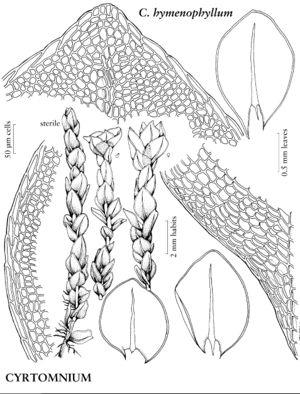Difference between revisions of "Cyrtomnium hymenophyllum"
Bryologist 60: 138. 1957.
FNA>Volume Importer |
FNA>Volume Importer |
||
| Line 33: | Line 33: | ||
|elevation=low to moderate elevations | |elevation=low to moderate elevations | ||
|distribution=Greenland;B.C.;Nfld. and Labr.;N.W.T.;Nunavut;Que.;Yukon;Alaska;Eurasia. | |distribution=Greenland;B.C.;Nfld. and Labr.;N.W.T.;Nunavut;Que.;Yukon;Alaska;Eurasia. | ||
| − | |discussion=<p>Cyrtomnium hymenophyllum often grows in pure stands in circumarctic and subarctic regions, in far northern North America, central west and central east Greenland, Europe, and Asia. It is readily recognized in the field by flat, bluish green leaves that are appressed against the dark brown stems. Plants growing in less optimal dry tundra are shorter and usually not matted together. The leaves are strongly heterophyllous, reflecting periods of fast and slow growth. Female plants are common throughout the range, and male plants occur more widely than those of C. hymenophylloides. Sporophytes are rare and have only been found in the Yukon (D. H. Vitt and D. G. Horton 1979), Northwest Territories, and British Columbia.</p> | + | |discussion=<p><i>Cyrtomnium hymenophyllum</i> often grows in pure stands in circumarctic and subarctic regions, in far northern North America, central west and central east Greenland, Europe, and Asia. It is readily recognized in the field by flat, bluish green leaves that are appressed against the dark brown stems. Plants growing in less optimal dry tundra are shorter and usually not matted together. The leaves are strongly heterophyllous, reflecting periods of fast and slow growth. Female plants are common throughout the range, and male plants occur more widely than those of <i>C. hymenophylloides</i>. Sporophytes are rare and have only been found in the Yukon (D. H. Vitt and D. G. Horton 1979), Northwest Territories, and British Columbia.</p> |
|tables= | |tables= | ||
|references={{Treatment/Reference | |references={{Treatment/Reference | ||
| Line 60: | Line 60: | ||
|publication year=1957 | |publication year=1957 | ||
|special status=Selected by author to be illustrated | |special status=Selected by author to be illustrated | ||
| − | |source xml=https://jpend@bitbucket.org/aafc-mbb/fna-data-curation.git/src/ | + | |source xml=https://jpend@bitbucket.org/aafc-mbb/fna-data-curation.git/src/8f726806613d60c220dc4493de13607dd3150896/coarse_grained_fna_xml/V28/V28_352.xml |
|genus=Cyrtomnium | |genus=Cyrtomnium | ||
|species=Cyrtomnium hymenophyllum | |species=Cyrtomnium hymenophyllum | ||
Revision as of 17:04, 18 September 2019
Plants 2–7(–20) cm. Stems erect, simple or branched distally; micronemata absent. Leaves not or lightly crisped when dry, 1.5–2(–2.5) mm; base long-decurrent; apex obtuse, acute, or rarely rounded, rarely short-apiculate; costa subpercurrent or rarely percurrent; medial laminal cells (25–)30–35(–40) µm; marginal cells short-linear or occasionally rhomboidal, in 1 (or 2) rows. Capsule arcuate; exostome lamellae 25–40. Spores 15–25 µm.
Phenology: Capsules mature summer.
Habitat: Wet, calcareous, peaty habitats, rich fens, drainage slopes with percolating water
Elevation: low to moderate elevations
Distribution

Greenland, B.C., Nfld. and Labr., N.W.T., Nunavut, Que., Yukon, Alaska, Eurasia.
Discussion
Cyrtomnium hymenophyllum often grows in pure stands in circumarctic and subarctic regions, in far northern North America, central west and central east Greenland, Europe, and Asia. It is readily recognized in the field by flat, bluish green leaves that are appressed against the dark brown stems. Plants growing in less optimal dry tundra are shorter and usually not matted together. The leaves are strongly heterophyllous, reflecting periods of fast and slow growth. Female plants are common throughout the range, and male plants occur more widely than those of C. hymenophylloides. Sporophytes are rare and have only been found in the Yukon (D. H. Vitt and D. G. Horton 1979), Northwest Territories, and British Columbia.
